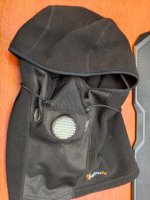What do you wear, how do you dress now that winter is coming? I do not have much body fat and get cold easily, especially hands and feet. Once my hand gets cold, they stay cold unless I soak them in hot water.
Bought these heated gloves and they are great (I paid $60, they are now $48 Cyber Monday sale)! Rode in 45 F this morning and my hands were toasty.
Bought these heated gloves and they are great (I paid $60, they are now $48 Cyber Monday sale)! Rode in 45 F this morning and my hands were toasty.
Last edited:






